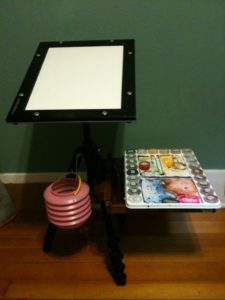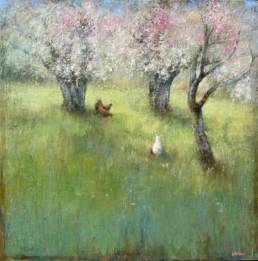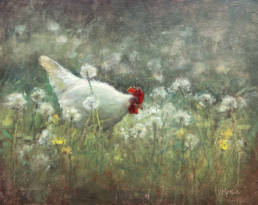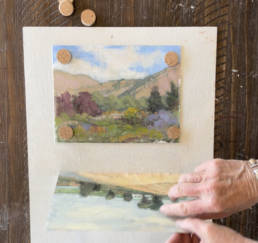It took me many years to find the perfect, portable watercolor painting setup.
After searching, I became increasingly disappointed with the commercial offerings for watercolor painters. Finally, I chose to create my own design. It’s defined by portability, compactness, and versatility.
As a watercolor painter, I have found that most easels and plein air pochade boxes that are currently on the market are designed for oil or acrylic painters which are merely “labeled” as being compatible with watercolor techniques and materials.
The reality is that these products always seem to be lacking some key elements that watercolor artists require because our painting surface is often positioned horizontally. Plus, we frequently need to tip our substrate in order to control the flow of washes and pigments.
A horizontal position rather than a vertical position is often necessary and reaching over a palette or drawer like many French easels or pochade boxes have can be awkward for watercolor painting.
I have often seen easels made of tripods that are commonly used for photography but they always seem to limit the movability of the substrate and seem to strive for more of a traditional non-adjustable easel in functionality.
The key piece that most of these tripod-modified easels lack is the addition of the “ball-head.” The ball-head was developed to allow photographers to quickly and easily adjust the position of their cameras in order to capture the perfect shot.
Because of its amazing range of motion, however, the ball-head can be the perfect positioning device for a watercolor board.
Here are 5 Steps to the Perfect Portable Watercolor Painting Setup
- I combined a Guerilla Painter Watercolor board with a built-in tripod mount or an aluminum Flex easel from Judson’s Art Supply to clamp an array of Otto Watercolor stretching boards.
- Either choice of watercolor paper mounting surface sturdily attaches to the ball-head of the tripod using a quick release plate.
- I can adjust the tension of the ball-head to allow the watercolor board to be twisted to virtually any angle or orientation which allows for excellent control of the flow of paint.
- By attaching a small side supply box which doubles as a shelf, all my artist materials are handy. My palette sets on the shelf and a small collapsible water bucket hangs in front.
- The setup collapses to an incredibly portable size and everything can fit in a small satchel.
I have finally created the perfect system for my painting style!
*****
Guest author/artist: Ken Powers lives in Tacoma, Washington. His still life paintings can be found in numerous public and private collections throughout the United States and abroad.








How do you attach a shelf to the tripod? I normally just use my lap for support, but this seems worth a try. Especially for anything more than a quick sketch. Thanks for sharing!
I hope Ken’s follow up comment helps to answer your question…just making sure.
Best-
Lori
Lori, I don’t see any follow up comment by Ken. Do I need to get a new prescription for my glasses?
Well, that is really strange Elisha. In fact, I am missing a string of comments from this post. I don’t know what happened, but a month ago Ken answered the same question from another reader and now those are not showing up. I will pass this question back to Ken and have him reply asap.
Thanks for your patience, Lori
Thanks for looking into it. I am really looking forward to the answer, I can’t wait to start building my own portable stand.
Hi Elisha, Ken just responded to your question. I hope his answer helps you build the watercolor easel to your liking. Good luck and let me know how it goes…
Thanks again for your patience!
Lori
There are two companies that I know of that offer shelves that attach to a tripod. One is Sienna Plein Aire. Their web address is: http://www.siennapleinair.com/. Theirs is really a supply box but I just set my palette on top. Then I have a supply box as well as a shelf.
The other company is Sun Eden which can be found here: http://www.sun-eden.com/. Theirs is strictly a shelf but it is very sturdy and perfect for all types of applications that require a shelf attached to a tripod. I have seen others that are designed for holding laptops, etc… for photographic applications but I have lost their site addresses.
Hope that information helps!
Ken, you are the best! Thanks for the follow up information. Our readers will be very happy. If you would ever like to share another great guest post or tip, please feel free to send it in!
Happy painting-
Lori
I likes paint with water color
i likes Sketch ( pencil )
So pls help visit my blog and pls your mention madam …;)
Hello Theofilus,
I hope you are enjoying watercolor painting and pencil drawing in 2012!
Lori
Hi Lori. I love your blog and am an avid reader of it. I’m probably a little off topic today, but I wanted to say how much I enjoy your wild horses video. I’ve seen it about 8 to 10 times and love it when I see the horses shelter the new fowl and when the stallion comes running up to check you out. Be assured there are still thousands of wild horses in Canada, especially up on the Nechaco Plateau area of British Columbia, west of the city of Williams Lake. Of course, if the truth be told, horses are not native to North America, but did thrive after the Spanish introduced them near end of the 15’th century or beginning of the 16’th century, circa 1495 to 1530 A.D.
Best regards from Vancouver Island,
Hans Lussenburg :o)
Hello Hans,
I am embarrassed to be so behind on replies. The holidays kept me busy and I am still catching up! Thank you for the extra nice comment. I am so glad to hear you are enjoying my blog – people like you make all this hard work worth the effort! I am happy to hear that wild horses are thriving in Canada. But, did you know that the first known horse fossils were found in Idaho…that’s right! They became extinct on this continent and were reintroduced by the Spaniards. Horses are not bad for our environment like cows and sheep, because the evolved here. Interesting stuff!
Cheers-
Lori
I would like suggestions on how to travel with large sheets of watercolor paper. I have a roll of 140 lb Arches and want to get a large sheet to relax. Put it in a tub of water and taped it to a large piece of cardboard. The cardboard folded as the paper dried. I don’t see how to pack a large gator board or some other rigid system like guerrilla board or boga board without adding to the size of my luggage.
I will ask the author to reply. Personally, I don’t travel with large watercolor paper so I am not sure. I am assuming you use the board for the support of you paper? You can pack smaller boards and use duct tape to connect them together for the support, once at your destination. Thanks for stopping by…
Lori,
I’m impressed with what you have developed professionally. I teach workshops and have a totally unique technique which I trademarked,but i have no time to write about it. Would you consider writing for art magazines for me?
Kath Macaulay
Many thanks for the nice feedback Kath. What kind of writing do you have in mind? Please email me lori@lorimcnee.com
Hi, I’m going crazy with tippy spinny easels and would like to try your tripod/watercolor board system. What brand ball head tripod fits with the watercolor board you mention?
Hello Kathy, I will ask Ken to get back to you with an answer. I didn’t write this post, so thanks for your patience.
🙂
Hi Lori
I am looking for a good ball-head tripod. What would you suggest? Which one do you use and what price range is it in?
Thanks
Lately, I have been using the Manfrotto tripod http://www.manfrotto.us/ It is very stable and easy to use. 🙂
Hi Lori, These were amazing tips. Was looking for a similar solution and like you said, most exist for oil/acrylic paintings. Do visit some of my works at http://www.raghaviyengar.wordpress.com and would love to have your feedback on moving forward! Thanks
Hello Raghav, I’m glad you enjoyed this post. I visited your blog and had fun seeing your passion for art. Thank you for visiting!